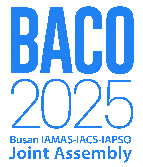Abstract for the Busan IAMAS-IACS-IAPSO Joint Assembly 2025
 Abstract for the Busan IAMAS-IACS-IAPSO Joint Assembly 2025
Abstract for the Busan IAMAS-IACS-IAPSO Joint Assembly 2025
Very high resolution simulations of a cumulus congestus: implications for cloud droplet formation and growth
Wojciech Grabowski(1), NCAR
Kamal Chandrakar(2), NCAR
Hugh Morrison(3), NCAR
This presentation will discuss three-dimensional simulations of a cumulus congestus cloud developing from a convective boundary layer that applies an unprecedented 7.5 m model grid spacing with detailed microphysics. The high resolution allows simulation of a cloud-scale circulation, embedded small-scale turbulence exported from the boundary layer, and entraining eddies aloft responsible for cloud dilution. Cloud microphysical processes are represented by Lagrangian particle-based microphysics, the so-called superdroplet method. High spatial resolution and Lagrangian microphysics allow high fidelity simulation of cloud processes, especially turbulence-microphysics interactions. The initial investigation considers the impact of cloud-base turbulence on the CCN activation and early growth of cloud droplets. Model results show that droplet spectra several hundred meters above the cloud base are wider than those predicted by an adiabatic parcel rising across the cloud base. The spectral width approaches 1 micron in the cloud model results versus only up to 0.2 micron in a reference non-turbulent adiabatic parcel. The difference comes from the small-scale turbulent vertical velocity fluctuations combined with the vertical velocity variability across the cloud base that are responsible for CCN activation variations. The more complete droplet growth equation that include kinetic, surface tension, and solute effects above the cloud base significantly adds to the variability of the droplet growth history and thus to the spectral width. An ongoing investigation explores the impact of resolved cloud turbulence and entrainment-mixing on the initial drizzle drop formation. Details of those results will be discussed at the conference.